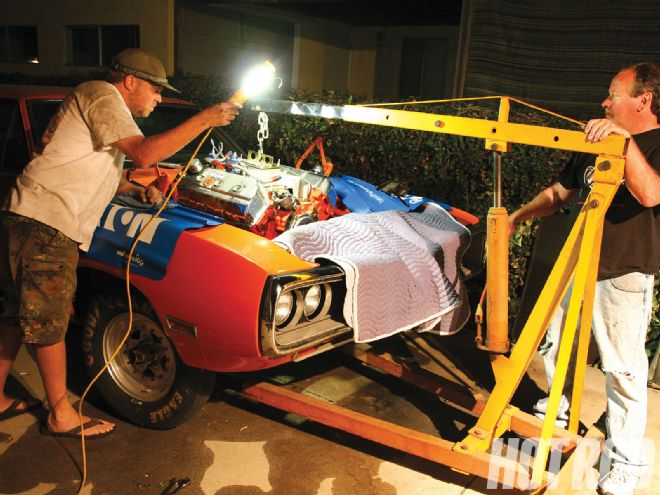
Why would we let our perfectly good Hemi rot for a decade-plus? We've long rehearsed an answer to that: because it's too radical for a street car and too slow for a race car. Now we're aiming to fix both ends of that dilemma.
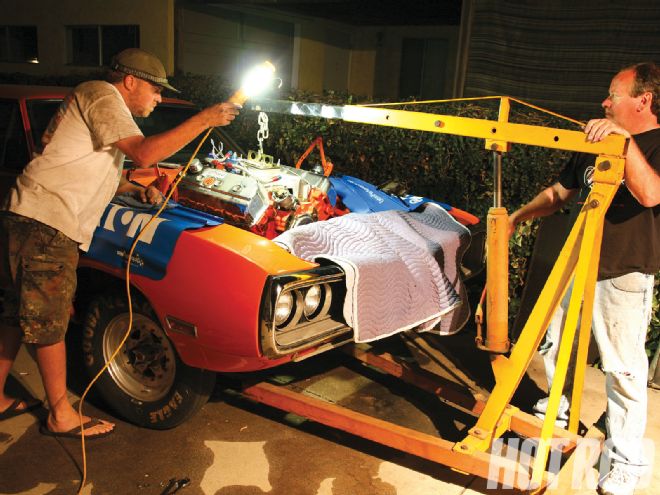 After being inert for 11 years, our '70 is getting revived, starting with refreshing the 484ci Hemi.
After being inert for 11 years, our '70 is getting revived, starting with refreshing the 484ci Hemi.
Last month's cover story retraced the life of project Rumble Bee, a '70 Dodge Super Bee that was partially built in the pages of HOT ROD in late 1995 and early 1996. It was also featured in Car Craft in 1999, then forsaken in a dusty garage. Until we pulled the engine out of the car for the conclusion of the article in our previous issue, the Dick Landy 484ci Hemi hadn't made noise for 11 years. Terminal neglect was an ignominious end for an engine with some great parts and a notable history. It had been assembled as a promotional tool for the launch of the reproduction-iron 426 Hemi blocks and heads from Mopar Performance. Larry Shepard was the man behind it at Mopar, and it was built by Mike Landy at Dick Landy Industries in Northridge, California. When the Hemi made 751 hp on pump gas on Landy's dyno, we were thrilled to death.
However, it also had a 7,600-rpm power peak. In our Super Bee, that required a 5,500-rpm torque converter and 5.13 gears for peak dragstrip performance, which turned out to be 10.60s at 128 mph at California's Famoso Raceway. Not bad for a pump-gas, naturally aspirated, 3,900-pound car with a relatively small 484-cube mill. Uncle Dick really wanted more and admitted to us that he was never in love with the intake manifold, which was a Mopar Performance dual-plane that had been heavily ported and converted to use a Dominator. Speaking of which, Mike was never too thrilled with our particular carburetor, either, as it seemed unresponsive to tuning changes. And now that we're recalling it, there was a problem of persistent misfire, too.
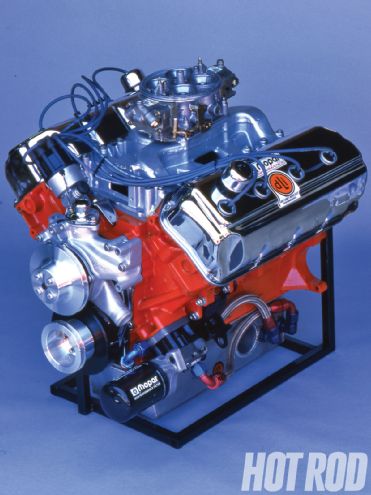 Here's the engine as it appeared in late 1995 when it was fresh off the dyno at Dick Landy Industries. Dick Landy died a little more than 10 years later, passing early at 69 years old in January 2007. The DLI shop closed soon after.
Here's the engine as it appeared in late 1995 when it was fresh off the dyno at Dick Landy Industries. Dick Landy died a little more than 10 years later, passing early at 69 years old in January 2007. The DLI shop closed soon after.
We never sorted out those issues. The car was too hairy to drive even a few miles on the highway to local cruise nights-forget 50 miles to the closest dragstrip. With the 5.13s and a sloppy converter, it buzzed 4,000 rpm at just 60 mph. The insane converter also made it soggy on the street, and the 4-inch Flowmaster cans were so stupidly loud that the cops would drop by when we moved the Bee around the block. It just wasn't much fun. So we parked it.
Now it's revival time. We've decided to tame down the Hemi by a few notches so we can really beat on it on the street, then spray the power back into it with nitrous. Another reason to back it down is that the bottom end uses stock connecting rods and massive 782-gram pistons (a JE big-block Chevy flat-top piston at the same bore size is around 580 grams, and domed ones are around 640). When it comes to abusing parts, we fear rpm far more than horsepower, and if we kept slinging those massive slugs at 8,000 rpm through the lights, we'd eventually be picking hunks of connecting rods out of the tires.
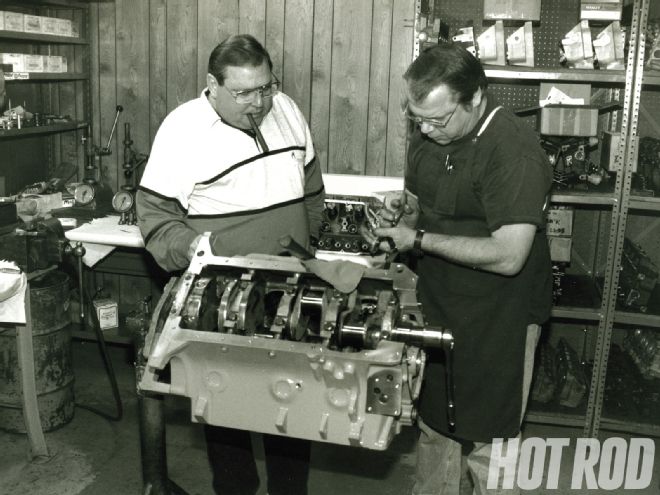 While the cigar-masticating Dick Landy was the famed racer, it was his pipe-smoking brother Mike (right) who did much of the mechanical work in the '60s and later at DLI. During the buildup of our Hemi, it was very interesting to watch the dynamic between these two big characters.
While the cigar-masticating Dick Landy was the famed racer, it was his pipe-smoking brother Mike (right) who did much of the mechanical work in the '60s and later at DLI. During the buildup of our Hemi, it was very interesting to watch the dynamic between these two big characters.
So, we lugged a massive load of Hemi iron to Westech Performance along with a stack of cams, intakes, carbs, and headers for what promised to be an exciting dyno session. But as you'll find out, we've had better days.
The Landy Combo
Our first step was to test the engine exactly as it came out of the car. We were dying to see how Landy's numbers from 15 years ago compared with Westech's now. With the exception of a Meziere water pump to replace the beltdriven pump and alternator, the Hemi was identical to how it had run in the Super Bee: same carb, same distributor, same tune-up, same lash, same headers. We did change the spark plugs and oil, using NGK plugs and Lucas 0-20-weight oil. We used light oil because the Hemi's dual-pickup Milodon oiling system used to make 120-plus psi with Valvoline Racing 40-weight, and it blew apart a filter once; it still topped 100 psi cold with the Lucas in the fabricated aluminum Stef's oil pan.
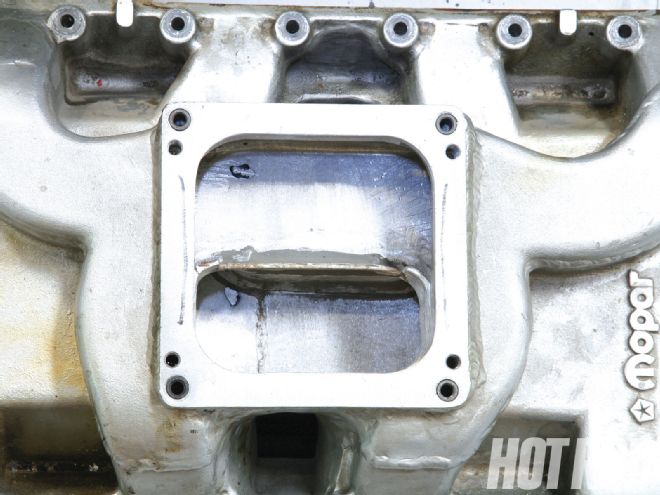 Here's a peek at the voodoo that DLI performed on the Mopar Performance M1 dual-plane intake, the same type that is still used on MP crate Hemis. This one is significantly oversized. Arrow Racing in Michigan also had devised some improvements on these intakes, and at one time Mopar had planned to compare the Landy and Arrow units and put the best one into production. That never happened, and the market is left without a high-rise, high-capacity dual-plane for Hemis.
Here's a peek at the voodoo that DLI performed on the Mopar Performance M1 dual-plane intake, the same type that is still used on MP crate Hemis. This one is significantly oversized. Arrow Racing in Michigan also had devised some improvements on these intakes, and at one time Mopar had planned to compare the Landy and Arrow units and put the best one into production. That never happened, and the market is left without a high-rise, high-capacity dual-plane for Hemis.
This Hemi uses a bore of 4.310 (0.060 inch oversized) and stroke of 4.150 (3.750 is stock) to make 484 ci. The bottom end uses a forged Mopar Performance crank and 6.86-inch rods that have been polished, peened, and treated to ARP bolts. The JE forged pistons squeeze 10.25:1 compression into reproduction iron heads that were ported to "maximum effort" levels (short of cutting and welding) by Mike Landy and upgraded with 2.320 titanium intake valves (2.250 is stock) and 1.900 exhaust valves (1.940 is stock).
The valvetrain starts with a Crane solid roller cam built to Landy's specs: 262/274 degrees of duration at 0.050, 0.659/0.659-inch lift, and a lobe-separation angle of 112 degrees. The rocker arms, shafts, and pedestals are all stock, but solid spacers instead of springs are used to locate the rocker arms on their shafts.
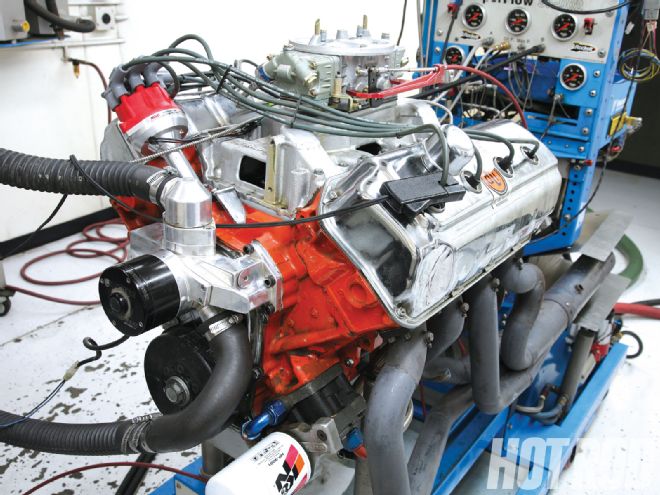 Here's the Landy Hemi back to life on the Westech dyno. This photo shows two changes that solved old problems: a new Holley Dominator carb and an MSD Pro Billet distributor to replace a sloppy stock electronic unit. The MSD is a lot taller than stock and may require clearance grinding on some Hemi intakes and valve covers. It also uses HEI-type cap terminals. We put new boots on our old wires but will need to get new, longer wires for the added height of the distributor.
Here's the Landy Hemi back to life on the Westech dyno. This photo shows two changes that solved old problems: a new Holley Dominator carb and an MSD Pro Billet distributor to replace a sloppy stock electronic unit. The MSD is a lot taller than stock and may require clearance grinding on some Hemi intakes and valve covers. It also uses HEI-type cap terminals. We put new boots on our old wires but will need to get new, longer wires for the added height of the distributor.
The bolt-ons start with a 1,050-cfm Holley Dominator built by the Carb Shop so long ago that founder Brad Urban was still running the place. He converted the three-circuit carb with two-circuit metering blocks, added his Super Boosters, and claimed a flow of 1,350 cfm. The carb sits on a Mopar M1 dual-plane intake that DLI cut in half horizontally so it could be hogged out to the max. The overall height was increased when it was welded back together, the plenum was enlarged, and it was converted from a 4150 flange to a 4500. Landy used a stock Mopar Performance electronic distributor and an MSD 7AL box. This Hemi was among the first to use the 440-style motor mount ears to bolt to the more readily available K-members, but that change required custom headers. We had those made with Landy's suggested 21/4-inch main tubes and 4-inch collectors.
Test 1: The Baseline
Once the Hemi was exerting its considerable mass on Westech's Superflow 902 dyno cart, we used a Mancini Racing tool to prelube the long-dry guts of the Hemi. With fuel in the bowls, it barked to life like it was 1996 again. We had forgotten exactly how loud this sucker was. But how would the numbers fare with those recorded by Landy so long ago?
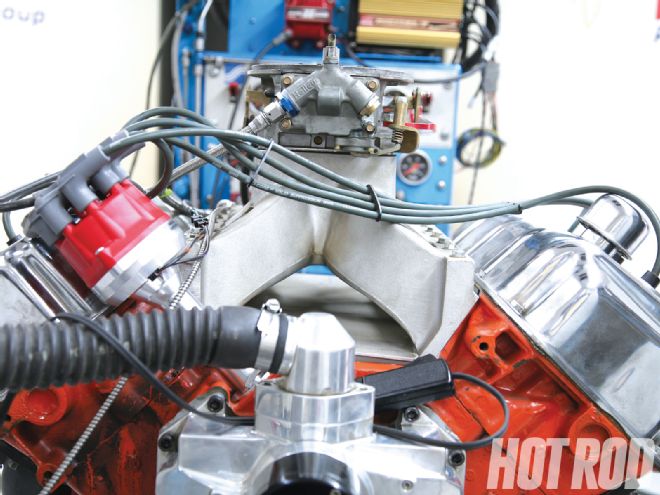 The Ray Barton intake manifold is a very tall single-plane with a Dominator flange. In past testing, we have compared it with stock M1 dual-planes and found the Barton unit to make huge improvements on big-cammed Hemis. That was not the case in this test as compared with our custom Landy intake.
The Ray Barton intake manifold is a very tall single-plane with a Dominator flange. In past testing, we have compared it with stock M1 dual-planes and found the Barton unit to make huge improvements on big-cammed Hemis. That was not the case in this test as compared with our custom Landy intake.
Pretty well, actually-but first, we had some work to do. The carb had exactly the same tune as when the car was last raced, yet it was far too lean-like with a 15.0:1 air/fuel ratio. It had jetting of 100s in the front and 99s in the rear along with power valve plugs. To richen the mixture, we had to add power valves in both metering blocks; the fuel flow through a power valve circuit is about what you'd see from increasing jet sizes by 6-8 numbers. We should have measured the air bleeds to give you real numbers, but we can say they appeared somewhat small, which would make the mixture even richer than with larger bleeds. The jetting size alone was unusually huge for an engine of this displacement and power. That may have been due to the two-circuit conversion. The old Dominator was so hinky that we also tested a new Holley PN 0-8896-1 three-circuit Dominator, and surprisingly, it moved almost exactly the same amount of fuel and made exactly the same power curve with its out-of-the-box jetting of 88 square and with a 5.5 power valve. We elected to keep the old Carb Shop unit in place for this dyno session, though we started to understand why Mike Landy saw insensitivity to jetting so many years ago.
Next we had to fight that old misfire. Turns out the problem was one that Dick Landy griped about during one of our trips to the track in 1996: The magnetic pickup in the stock electronic distributor was a flopper, leading to a poor trigger signal. We'll shove that thing off to someone in love with the cable-drive-tach housing and be proud of our new MSD Pro Billet distributor that cleared up the problem. The engine was happiest at 32 degrees of total timing with Rockett Brand 100-octane unleaded gas in the tank.
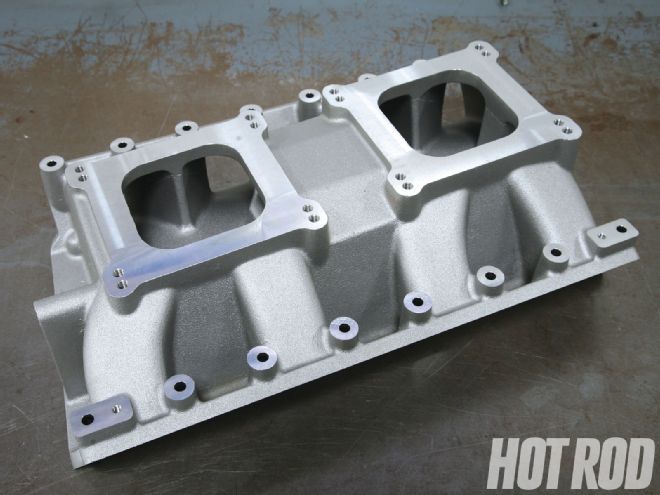 The Stage V Engineering dual-quad manifold is a very nice casting. It's a low-rise single-plane with short runners and is 1/4 inch taller than a stock Hemi intake. Arruza Performance offers a shorter one to work with stock hoods. This intake accepts Carter and Edelbrock carbs and side-hung float-bowl Holleys.
The Stage V Engineering dual-quad manifold is a very nice casting. It's a low-rise single-plane with short runners and is 1/4 inch taller than a stock Hemi intake. Arruza Performance offers a shorter one to work with stock hoods. This intake accepts Carter and Edelbrock carbs and side-hung float-bowl Holleys.
In September 1995 on Dick Landy's Superflow 901 dyno, the Hemi screamed out 573 lb-ft at 5,800 rpm and 751 hp at 7,600 rpm. In April 2010 on Westech's Superflow dyno, it peaked at 558 lb-ft at 5,600 rpm . . . but we never made it to the horsepower peak. Whether due to dragstrip over-revs or deterioration in pressure from sitting compressed for 11 years, the valvesprings lost control of the valves at 7,100 rpm. Even so, the engine was on the same track as it had been at Landy's. Westech's peak torque number was lower by 15 numbers than the original test at Landy's, though at essentially the same rpm. All the power numbers below 6,400 rpm were just slightly lower than Landy's report, but the Westech results from 6,400 to 7,100 rpm were within five numbers of matching it. The power curves were amazingly close for two different dynos and operators 15 years apart. It probably would have seen 720 to 730 hp if we'd run it to 7,600.
Test 2: A Smaller Cam
It's uncharacteristic for us to de-cam an engine for driveability. We must be getting old. We used an old 'stick we had sitting around, a Crane Powermax solid roller (PN 668521, no longer available) with specs of 246/254 degrees of duration at 0.050, lift of 0.568/0.568 inch, and a lobe-separation of 112 degrees. That means we pulled out 16/20 degrees of duration and a theoretical 0.091 inch of lift (lash changed from 0.030 to 0.022, so the net lift change was actually 0.083 inch).
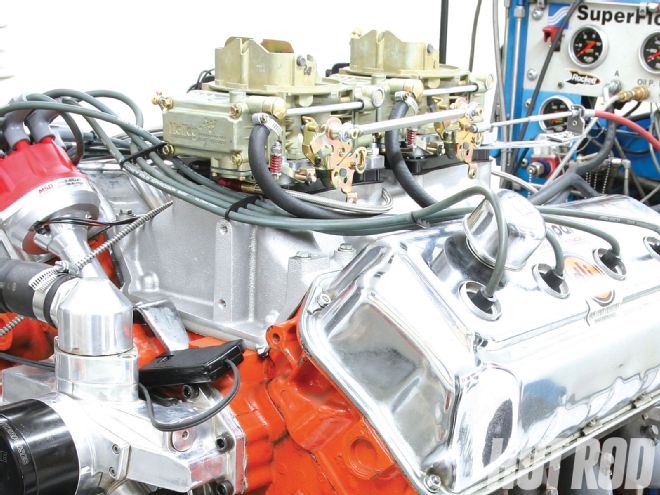 The dual-quads look cool on the Hemi but oddly reminded us of an FE Ford with an inline intake. We chose the dichromate (gold) carbs instead of the new silver ones because they look more correct. Cassel Enterprises sells linkage for this setup that bolts up cleanly and uses a Mopar muscle car's stock-style throttle cable.
The dual-quads look cool on the Hemi but oddly reminded us of an FE Ford with an inline intake. We chose the dichromate (gold) carbs instead of the new silver ones because they look more correct. Cassel Enterprises sells linkage for this setup that bolts up cleanly and uses a Mopar muscle car's stock-style throttle cable.
With all other factors remaining the same, the wimpier cam reduced the rpm at peak torque by 1,000 points and the rpm at peak power by 1,400 to 1,600. Instead of a 7,800-rpm engine, we now had a 6,500-rpm mill. Rather than a choppy, 1,300-rpm idle, we now had a somewhat rumbly 900-rpm idle. The goal of taming it down had been reached.
Of course, we also lost power. The smaller cam delivered a peak horsepower of 599 at 6,000 rpm and torque of 578 lb-ft at 4,600 rpm. For bench racing, it's a bummer to give up 120 to 150 hp, but the good news for street performance is that the 246/254 cam made more torque and horsepower than the 262/272 unit at every data point below 5,500 rpm. The rehashed Hemi has a powerband of 2,800 to 6,800 rather than 5,500 to 8,000.
Test 3: Single-Plane Intake
Dick Landy once quipped, "We'd make another 75 hp on this thing with a decent tunnel-ram." Of course, he said that while pointing to a $5,000 fabricated sheetmetal cross-ram, but the message was that ditching the dual-plane would be worth top-end power. We've always bought into that theory, so we installed a high-rise Ray Barton intake and waited for greatness.
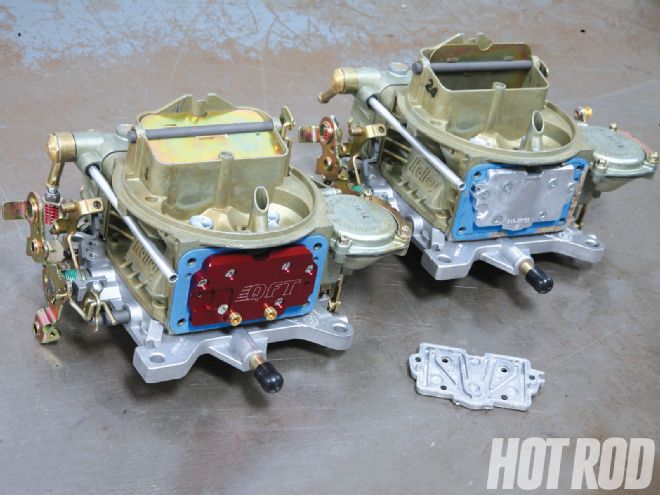 If you plop a Stage V intake and two out-of-the-box 1850s on nearly any Hemi, the engine will run deadly lean. We had to richen ours drastically, going from factory 64 jets in the front to 71s, removing the factory No. 9 metering plate (equivalent to 64 jets) in the back, and adding a jet plate to allow screw-in-style No. 72 jets. Quick Fuel Technologies and AED Performance offer billet plates to allow 4160-style Holley carbs to use unscrewable jets rather than the stock, nonadjustable metering plates. This is needed because the Stage V intake does not allow the front carb to use a longer secondary metering block.
If you plop a Stage V intake and two out-of-the-box 1850s on nearly any Hemi, the engine will run deadly lean. We had to richen ours drastically, going from factory 64 jets in the front to 71s, removing the factory No. 9 metering plate (equivalent to 64 jets) in the back, and adding a jet plate to allow screw-in-style No. 72 jets. Quick Fuel Technologies and AED Performance offer billet plates to allow 4160-style Holley carbs to use unscrewable jets rather than the stock, nonadjustable metering plates. This is needed because the Stage V intake does not allow the front carb to use a longer secondary metering block.
It didn't come. To our surprise, the engine struggled to make a smooth curve with the big manifold installed and didn't make any more power except from 6,100 to 6,500 rpm. It did produce the best peak horsepower with the small cam-615 hp at 6,500 rpm-but this intake clearly requires a larger displacement or more engine speed to shine. We wish we'd tried it with the big cam, but it looked like Uncle Dick should not have been so leery of his ported M1.
Test 4: Dual-Quad Intake
We've always had a nagging sense that the single carb atop our Hemi just wasn't right. All Hemis in nature have dual-quads. We hunted for options. There's the reproduction stock Street Hemi intake, but it only accepts Carter-type carbs and is flow limited. Mopar Performance has a dual-plane dual-quad spaced for Holleys, but we did not get one in time to test it. We did have a Mopar cross-ram, but it's too hairy for a Hemi like ours. Indy Cylinder Heads offers an interesting box ram called the Mod Man with interchangeable lids for a single four, dual Carters, or a Six Pack, and maybe we'll try it someday. But for now, we settled on the popular medium-rise single-plane from Stage V Engineering; it's drilled for either Carters or Holleys.
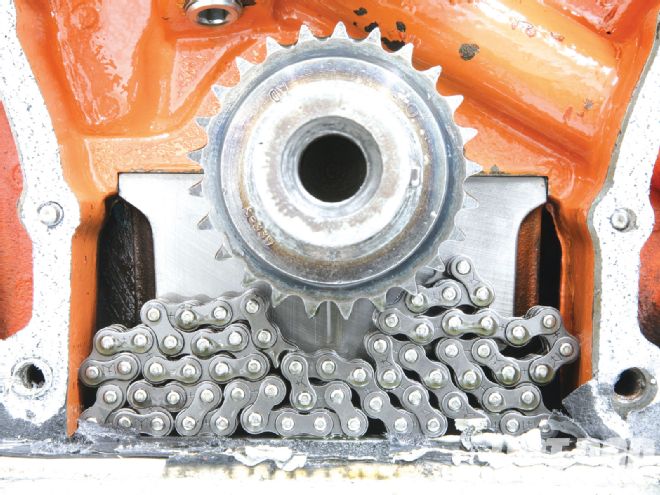 Here's a day killer: a broken stock-style timing chain. We're lucky it did not wad itself up and break the block or oil pan, and it also did not throw parts into the oil pan.
Here's a day killer: a broken stock-style timing chain. We're lucky it did not wad itself up and break the block or oil pan, and it also did not throw parts into the oil pan.
To fit a Stage V intake, the Holley carbs must have side-hung float bowls and no secondary metering blocks. That pretty much narrows the choices to three: 1) Holley's reproduction, 770-cfm Hemi cross-ram carbs at nearly $1,300 a pair 2) Demon Carburetion's Road Demon Jr.s at $274.99 to $324.99 at Jegs (price depends on choke and linkage style) or 3) the basic 1850-series, 600-cfm, vacuum-secondary carbs at $253.95 each at Summit Racing. We went with the 1850s.
We hoped the Stage V dual-quad would produce power that was close enough to the Landy dual-plane that we could justify running it. On one end, the Stage V delivered 611 hp at 6,300 rpm, which was 12 better than the dual-plane and the Dominator. The downer is that the dual-quad made less torque than the two-planer at points below 5,700 rpm. The Stage V made 551 lb-ft and the Landyfied dual-plane hit 578, a difference of 27 lb-ft. The average power from 3,300 to 6,500 rpm with the Stage V was 533 lb-ft and 498 hp, pretty close to the Landy hunk at 543 lb-ft and 500 hp.
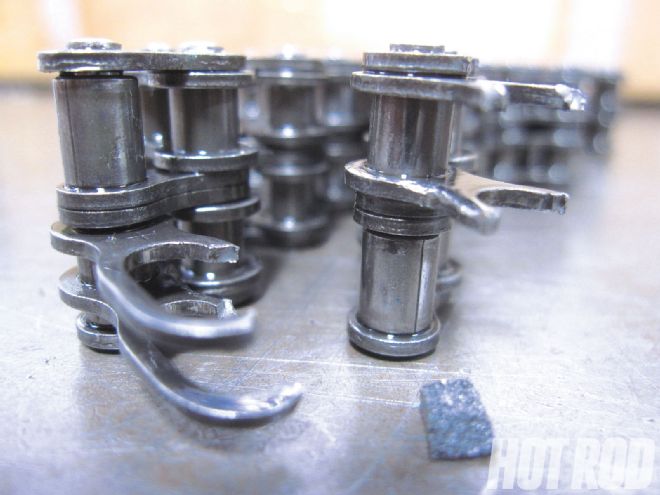 It looks like one link in the chain broke on one half, then stretched out and snapped the other half. We can't tell if that happened before or after a tooth snapped off the timing gear. We'll use quality billet stuff next time.
It looks like one link in the chain broke on one half, then stretched out and snapped the other half. We can't tell if that happened before or after a tooth snapped off the timing gear. We'll use quality billet stuff next time.
Eh, so nitrous can blow through those minor differences. Too bad we didn't get a chance to prove that.
UH-OH
Disaster. We were on the final dyno pull before starting header testing. The Hemi was at 6,100 rpm when-bang!-a fireball shot from the carbs, then the dyno cell fell silent. That's rarely a great moment.
The timing chain broke, the camshaft reverted to still life, and most of the megabuck titanium intake valves got intimate with the pistons. It looks like we can fix it without digging into the short-block, but our test day was lynched, our Super Bee revival plan delayed, and our wallet further ransacked. Dang it.
Conclusions, The Future
We normally view the glass as half broken, but with this particular snafu, we're seeing a chance to make the Hemi better than we may otherwise have done. The fragged valvetrain gives us the chance to upgrade the cam yet again. The Hemi's current performance is still a little below average for what it is, but we think we can make it better with some lobe love. We're also going to round up some extra headers to test next time.
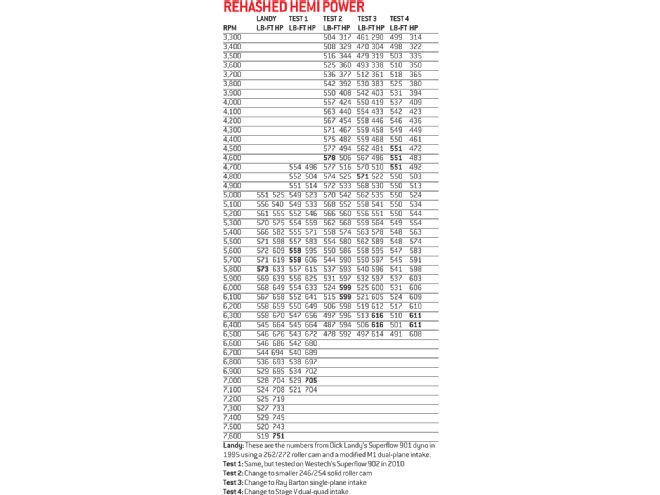 Rehashed HEMI Power Tech Chart.
Rehashed HEMI Power Tech Chart.
It strikes us that there's no Hemi intake manifold on the market that's in between the mediocre Mopar single-quad dual-plane on the current crate engines and the higher-end units such as the Barton four-barrel or the Indy tunnel-rams. The Stage V dual-quad seems a good compromise, so we'd better test the Mopar dual-plane version, too. But even now, we're conflicted as to what we should do with the intake even if we can find a strong dual-quad combo: Do we embrace the curb appeal of twin carbs atop dual nitrous plates, or is there merit in retaining the legacy of the one-off, Landy-molested intake and the single Dominator? If so, we need to round up a more streetable two-circuit carb.
Finally, we hafta try the nitrous. But the question is . . . can we get it fixed in time for next month's issue? We hope so. But one thing is for sure: We're not going to abandon the Super Bee again before this is through.